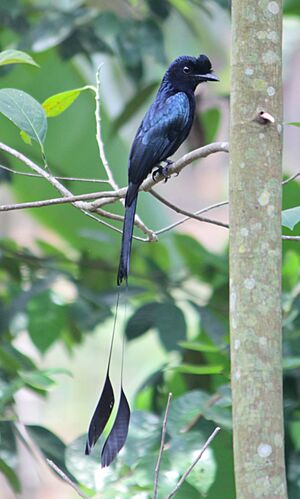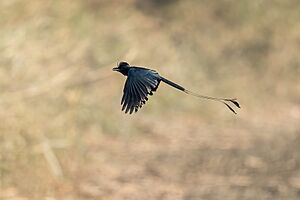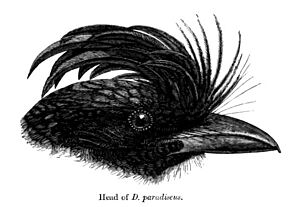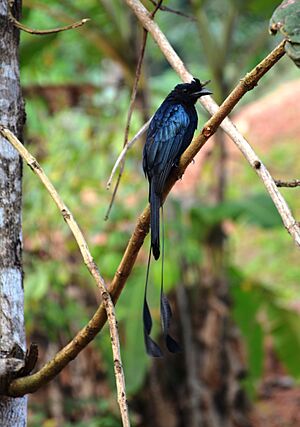Greater racket-tailed drongo facts for kids
Quick facts for kids Greater racket-tailed drongo |
|
|---|---|
 |
|
| Conservation status | |
| Scientific classification | |
| Genus: |
Dicrurus
|
| Species: |
paradiseus
|
| Synonyms | |
|
|
The Greater Racket-tailed Drongo (scientific name: Dicrurus paradiseus) is a cool bird from Asia. It's easy to spot because of its unique tail. The outer tail feathers are very long, with a special flat part only at the very end. This makes them look like two little rackets!
These birds belong to a group called drongos. You'll often see them sitting out in the open in forests. They love to get attention with their loud calls. What's really amazing is that they can perfectly copy the calls of many other birds. Scientists think this might help them join mixed-species foraging flocks. These are groups where different kinds of birds hunt for insects together. Sometimes, these drongos even steal food from other birds in the flock! They are active during the day, but you might hear them calling early in the morning or late in the evening.
Contents
Meet the Greater Racket-tailed Drongo
The Greater Racket-tailed Drongo is one of the biggest drongo species in Asia. You can easily tell it apart by its special tail and a crest of curled feathers on its head. This crest starts above its beak and goes along the top of its head. The size and shape of the crest can be different depending on where the bird lives.
When the drongo flies, its unique tail rackets make it look like two big bees are chasing a black bird! In some areas, like the eastern Himalayas, it might be confused with the lesser racket-tailed drongo. But the lesser drongo has flat rackets and almost no crest.
This bird lives in many different places, so there are several types, called subspecies. They all have slight differences. For example:
- The type found in southern India has a certain look.
- The one in Sri Lanka (called ceylonicus) is a bit smaller.
- The grandis subspecies, found in the Himalayas, is the largest and has long, shiny neck feathers.
- Birds on the Andaman Islands (otiosus) have shorter neck feathers and a much smaller crest.
- The Nicobar Islands type (nicobariensis) has a longer crest on its forehead.
Young drongos are not as brightly colored. They might not have a crest yet. When they are changing their feathers, they might also lose their long tail streamers for a while. The "racket" part of the tail is actually made from the inner part of the feather. But it looks like it's on the outer part because the feather stem twists just above the racket.
Where Do Greater Racket-tailed Drongos Live?
These birds live in a wide area across Asia. You can find them from the western Himalayas all the way to the eastern Himalayas. They live in the foothills below 1,200 meters (about 3,900 feet). They also live in the hills of India and the Western Ghats. Their home continues east through the mainland and islands, including Borneo and Java.
Amazing Behavior of the Drongo
Like other drongos, these birds mostly eat insects. But they also enjoy fruit and will visit flowering trees to drink nectar. They have short legs, so they often sit upright on high, open branches. They are quite brave and will sometimes chase away bigger birds, especially when they are nesting. They are often active when the sun is setting.
Their calls are incredibly varied! They make repeated whistles, metallic sounds, and complex notes. They can also perfectly copy the calls of other birds. They start calling very early, sometimes even at 4 AM when the moon is still out. Their calls can sound like a metallic "tunk-tunk-tunk."
One cool thing about them is their ability to copy the alarm calls of other birds. They learn these calls by interacting with other birds in mixed-species flocks. This is special because most birds that mimic sounds don't seem to understand what the original sound means. But the drongo uses these alarm calls in the right situation. It's like a human learning useful phrases in different languages! For example, they have a special alarm call for when a shikra (a type of hawk) is near.
Some people think drongos copy hawk calls to scare other birds. Then, while the other birds are panicking, the drongo can steal their food! They also copy the calls of birds that are usually part of mixed-species flocks, like babblers. This might help them form these groups. Sometimes, they act as "kleptoparasites," meaning they steal food from others in the flock, especially laughingthrushes. But usually, they have helpful relationships with other birds. Observers have seen drongos following woodpeckers and even groups of monkeys to find food.
Reproduction and Life Cycle
The Greater Racket-tailed Drongo lives and breeds in the same areas all year round. In India, their breeding season is from April to August. During courtship, they might hop and turn on branches. They also play games, like dropping an object and catching it in mid-air!
They build a cup-shaped nest in the fork of a tree. They often choose trees with smooth trunks and isolated canopies. The nesting pair might even remove bits of bark to make the trunk smoother. A female usually lays three to four eggs. The eggs are creamy white with reddish-brown spots, which are thicker at the wider end.

The Drongo in Culture
The drongo's common whistle call has given it local names in many parts of India. It's called kothwal, which means "policeman" or "guard." This is because old-time policemen used a whistle that sounded similar. It's also known as Bhimraj or Bhringaraj.
In the Mizo language of northeast India, it's called Vakul. The Mizo people use the drongo's tail feathers in their ceremonies. Before the 1950s, people in parts of India often kept these birds as pets. They were known to be very tough and could eat many different kinds of food, just like a crow. Some historians even believe the Greater Racket-tailed Drongo might be the basis for the divine kalaviṅka birds mentioned in old Chinese and Japanese Buddhist texts.




